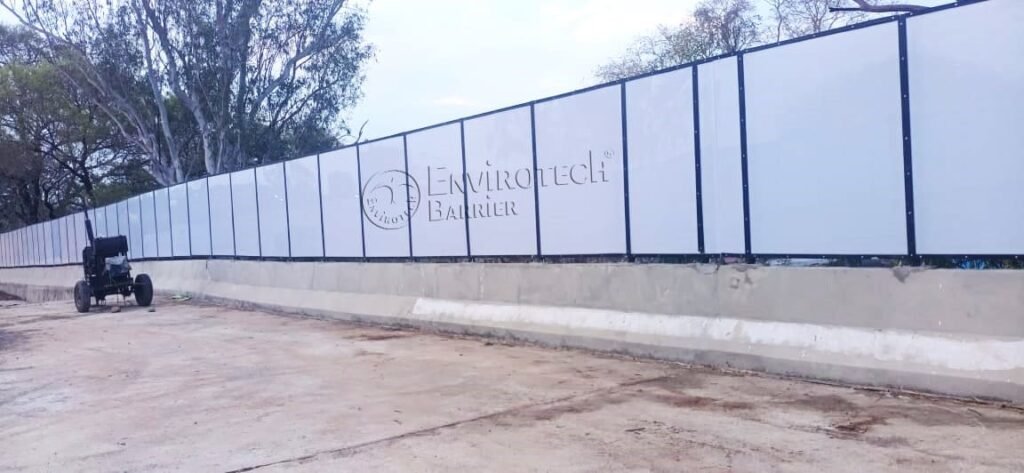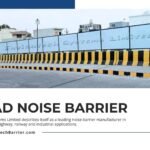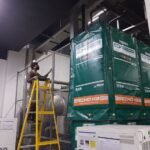![]()
What Is a Noise Barrier and How Does It Work?

Noise pollution has become one of the major challenges in modern cities, industrial zones, and transportation hubs. With the growth of highways, railways, airports, and manufacturing plants, controlling unwanted sound is essential for healthier living and working environments. One of the most effective solutions to reduce noise pollution is the installation of noise barriers. These structures are widely used worldwide to block or absorb excessive noise and create peaceful surroundings.
What Is a Noise Barrier?
A Noise Barrier, also known as a sound wall or acoustic barrier, is a specially designed structure that helps in reducing the impact of noise. It acts as a shield between the noise source (such as highways, factories, or railways) and the receiver (residential or commercial areas). Unlike ordinary walls, noise barriers are engineered with acoustic materials that either reflect or absorb sound waves. This makes them far more effective in reducing unwanted noise levels.
Noise barriers are available in various forms such as concrete barriers, metal panels, wooden barriers, transparent acrylic barriers, and vegetative barriers. Depending on the project requirements, they can be designed for durability, aesthetics, and performance.
How Do Noise Barriers Work?
Noise travels in the form of sound waves. When these waves encounter a barrier, their movement is either blocked, absorbed, or redirected. A well-designed acoustic barrier works on three main principles:
- Reflection of Sound: Many noise barriers are designed to reflect sound waves back toward the source, preventing them from traveling to the protected side.
- Absorption of Sound: Barriers made with sound-absorbing materials such as mineral wool, perforated metal sheets, or acoustic composites reduce sound by absorbing the energy of the waves.
- Diffusion and Redirection: In some designs, noise barriers redirect sound waves upward into the atmosphere, minimizing their impact on nearby residents and workplaces.
The effectiveness of a noise barrier depends on its height, length, thickness, and material. A taller and denser barrier will provide higher noise reduction.

Types of Noise Barrier
- Metallic Noise Barriers: Metallic noise barriers are one of the most effective solutions for blocking unwanted sound. Manufactured using advanced technology, these barriers are designed for durability, strength, and long-lasting performance. They provide reliable noise control in urban, industrial, and commercial environments, ensuring peace and comfort for surrounding areas.
- Road Noise Barriers: Road noise barriers are specially engineered to reduce the impact of traffic noise along highways, flyovers, and busy roads. By obstructing the direct path of sound waves from vehicles, these barriers significantly lower noise levels for nearby residential and commercial communities, improving overall quality of life.
- Polycarbonate Noise Barriers: Polycarbonate noise barriers are a modern and highly effective solution for sound insulation. Known for their superior acoustic properties, polycarbonate panels are lightweight, durable, and cost-efficient compared to traditional materials. They not only absorb sound effectively but also maintain visibility, making them ideal for highways, urban areas, and aesthetically sensitive projects.
- Temporary Noise Barriers: Temporary noise barriers are designed for short-term projects such as construction sites, events, or maintenance work. Lightweight and portable, they are easy to install, relocate, and dismantle. With the ability to reduce noise levels by up to 30dB, temporary noise barriers create a quieter and safer working environment without the need for constant ear protection.
- Railway Noise Barriers: Railway noise barriers are installed along railway tracks and stations to minimize the impact of train noise on nearby buildings and public spaces. Built with sound-absorbing and insulating materials, these barriers effectively block harsh noise and vibrations, ensuring a quieter atmosphere for communities near rail networks, parking areas, and convention centers.
- Construction Site Noise Barriers: Construction site noise barriers are the ideal solution to control noise pollution in residential and urban areas near ongoing projects. These barriers reduce the disruptive sounds of heavy machinery and construction activities, helping maintain community comfort while ensuring compliance with environmental noise regulations.
Benefits of Noise Barriers
- Effective reduction of noise pollution.
- Improved comfort for residents and workers.
- Enhanced property value in quieter neighborhoods.
- Customizable designs to match urban and industrial architecture.
- Contribution to a healthier and more sustainable environment.
Applications of Noise Barriers
- Highways and Roads: To minimize traffic noise for nearby residential areas.
- Railways: To control vibrations and noise from trains.
- Airports: To reduce aircraft takeoff and landing noise.
- Industrial Plants: To block noise from heavy machinery and compressors.
- Residential and Commercial Projects: To create peaceful and noise-free environments.
A Noise Barrier is more than just a wall—it is an essential solution to combat increasing noise pollution in modern society. By reflecting, absorbing, or redirecting sound waves, noise barriers help create comfortable living and working spaces. Whether for highways, railways, or industrial sites, investing in high-quality acoustic barriers is a smart choice for long-term noise control.




